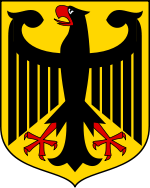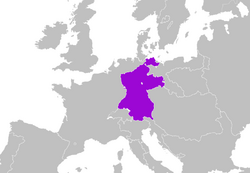Confederation of the Rhine
|
|||||||||||||||||||||||||||||||||||||||||
The Confederation of the Rhine or Rhine Confederation (German: Rheinbund; French: États confédérés du Rhin officially and Confédération du Rhin in practice) was a confederation of client states of the First French Empire. It was formed initially from 16 German states by Napoleon after he defeated Austria's Francis II and Russia's Alexander I in the Battle of Austerlitz. The Treaty of Pressburg, in effect, led to the creation of the Confederation of the Rhine. It lasted from 1806 to 1813.
The members of the confederation were German princes (Fürsten) from the Holy Roman Empire. They were later joined by 19 others, all together ruling a total of over 15 million subjects providing a significant strategic advantage to the French Empire on its eastern front.
Contents |
Formation
On 12 July 1806, on signing the Treaty of the Confederation of the Rhine (German: Rheinbundakte), 16 states in present-day Germany formally left the Holy Roman Empire and joined together in a confederation (the treaty called it the états confédérés du Rhin, with a precursor in the League of the Rhine). Napoleon was its "protector." On 6 August, following an ultimatum by Napoleon, Francis II gave up his title of Emperor and declared the Holy Roman Empire dissolved. In the years that followed, 23 more German states joined the Confederation; Francis's Habsburg dynasty would rule the remainder of the empire as Austria. Only Austria, Prussia, Danish Holstein, and Swedish Pomerania stayed outside, not counting the west bank of the Rhine and Principality of Erfurt, which were annexed by the French empire.
According to the treaty, the confederation was to be run by common constitutional bodies, but the individual states (in particular the larger ones) wanted unlimited sovereignty.
Instead of a monarchical head of state, as the Holy Roman Emperor had been, its highest office was held by Karl Theodor von Dalberg, the former Arch Chancellor, who now bore the title of a Prince-Primate of the confederation. As such, he was President of the College of Kings and presided over the Diet of the Confederation, designed to be a parliament-like body though it never actually assembled. The President of the Council of the Princes was the Prince of Nassau-Usingen.
The Confederation was above all a military alliance: the members had to supply France with large numbers of military personnel. In return for their cooperation some state rulers were given higher statuses: Baden, Hesse, Cleves, and Berg were made into grand duchies, and Württemberg and Bavaria became kingdoms. States were also made larger by incorporating the many smaller "Kleinstaaten," or small former imperial member states.
After Prussia lost to France in 1806, many medium-sized and small states joined the Rheinbund. It was at its largest in 1808, including four kingdoms, five grand duchies, 13 duchies, seventeen principalities, and the Free Hansa towns of Hamburg, Lübeck, and Bremen.
In 1810 large parts of northwest Germany were quickly incorporated into the Napoleonic Empire in order to better monitor the trade embargo with Great Britain, the Continental System.
The Confederation of the Rhine collapsed in 1813, with the aftermath of Napoleon's failed campaign against the Russian Empire. Many of its members changed sides after the Battle of the Nations, when it became apparent Napoleon would lose the War of the Sixth Coalition.
Member monarchies
The following table shows the members of the confederation, with their date of joining, as well as the number of troops provided, listed in parenthesis.[3]
| History of Germany | |
|---|---|
 This article is part of a series |
|
| Early History | |
| Germanic peoples | |
| Migration Period | |
| Frankish Empire | |
| Medieval Germany | |
| East Francia | |
| Kingdom of Germany | |
| Holy Roman Empire | |
| Eastward settlement | |
| Early Modern period | |
| Sectionalism | |
| 18th century | |
| Kingdom of Prussia | |
| Unification of Germany | |
| Confederation of the Rhine | |
| German Confederation & Zollverein | |
| German Revolutions of 1848 | |
| North German Confederation | |
| The German Reich | |
| German Empire | |
| World War I | |
| Weimar Republic Saar, Danzig, Memel, Austria, Sudeten |
|
| Nazi Germany | |
| World War II Flensburg government |
|
| Germany since 1945 | |
| Occupation + Ostgebiete | |
| Expulsion of Germans | |
| FRG, Saar & GDR | |
| German reunification | |
| reunified Germany | |
| Topics | |
| Military history of Germany | |
| Territorial changes of Germany | |
| Timeline of German history | |
|
Germany Portal |

The College of Kings
| Flag | Member monarchy | Year joined | Notes |
|---|---|---|---|
| Grand Duchy of Baden | 12 July 1806 | Co-founder; former margraviate (8000) | |
| Kingdom of Bavaria | 12 July 1806 | Co-founder; former duchy (30,000) | |
| Grand Duchy of Berg | 12 July 1806 | Co-founder; absorbed Cleves, both formerly Duchies (5000) | |
| Grand Duchy of Hesse-Darmstadt | 12 July 1806 | Co-founder; former landgraviate (4000) | |
| Principality of Regensburg | 12 July 1806 | Co-founder; formerly Prince-Archbishopric and Electorate; after 1810 the |
|
| Kingdom of Saxony | 11 December 1806 | Former duchy (20,000) | |
| Kingdom of Westphalia | 15 November 1807 | Napoleonic creation (25,000) | |
| Kingdom of Württemberg | 12 July 1806 | Co-founder; former duchy (12,000) | |
| Grand Duchy of Würzburg | 23 September 1806 | Napoleonic creation (2000) |
The College of Princes
| Flag | Member monarchy | Year joined | Notes |
|---|---|---|---|
| Duchy of Anhalt-Bernburg | 11 April 1807 | (700) | |
| Duchy of Anhalt-Dessau | 11 April 1807 | (700) | |
| Duchy of Anhalt-Köthen | 11 April 1807 | (700) | |
| Duchy of Arenberg | 12 July 1806 | Co-founder; mediatized 13 December 1810 (4000) | |
| Principality of Hohenzollern-Hechingen | 12 July 1806 | Co-founder (4000) | |
| Principality of Hohenzollern-Sigmaringen | 12 July 1806 | Co-founder (4000) | |
| Principality of Isenburg-Birstein | 12 July 1806 | Co-founder (4000) | |
| Principality of Leyen | 12 July 1806 | Co-founder; former countship or graviate (4000) | |
| Principality of Liechtenstein | 12 July 1806 | Co-founder (4000) | |
| Principality of Lippe-Detmold | 11 April 1807 | (650) | |
| Duchy of Mecklenburg-Schwerin | 22 March 1808 | (1900) | |
| Duchy of Mecklenburg-Strelitz | 18 February 1808 | (400) | |
| Duchy of Nassau (Usingen and Weilburg) | 12 July 1806* | Union of |
|
| Duchy of Oldenburg | 14 October 1808 | annexed by France 13 December 1810 (800) | |
| Principality of Reuss-Ebersdorf | 11 April 1807 | (400) | |
| Principality of Reuss-Greiz | 11 April 1807 | (400) | |
| Principality of Reuss-Lobenstein | 11 April 1807 | (400) | |
| Principality of Reuss-Schleiz | 11 April 1807 | (400) | |
| Principality of Salm (Salm-Salm and Salm-Kyrburg) | 25 July 1806 | Co-founder; annexed by France 13 December 1810 (4000) | |
| Duchy of Saxe-Coburg | 15 December 1806 | (part of 2000 for Saxe duchies) | |
| Duchy of Saxe-Gotha | 15 December 1806 | (part of 2000 for Saxe duchies) | |
| Duchy of Saxe-Hildburghausen | 15 December 1806 | (part of 2000 for Saxe duchies) | |
| Duchy of Saxe-Meiningen | 15 December 1806 | (part of 2000 for Saxe duchies) | |
| Duchy of Saxe-Weimar | 15 December 1806 | (part of 2000 for Saxe duchies) | |
| Principality of Schaumburg-Lippe | 11 April 1807 | (650) | |
| Principality of Schwarzburg-Rudolstadt | 11 April 1807 | (650) | |
| Principality of Schwarzburg-Sondershausen | 11 April 1807 | (650) | |
| Principality of Waldeck | 11 April 1807 | (400) |
Aftermath
The allies opposing Napoleon dissolved the Confederation of the Rhine 4 November 1813. After its demise, the only attempt at political coordination in Germany until the creation on 8 June 1815 of the German Confederation was a body called the Central Administration Council (German: Zentralverwaltungsrat); its President was Heinrich Friedrich Karl Reichsfreiherr vom und zum Stein (1757 – 1831). It was dissolved on 20 June 1815.
On 30 May 1814 the Treaty of Paris declared the German states independent.
In 1815, the Congress of Vienna redrew the continent's political map. In fact, most surviving members had only minor border changes, and the resulting German Confederation consisted more or less of the same members as the Confederation of the Rhine, with the important addition of the two German great powers of Austria and Prussia.
See also
References
Sources and external links
- Confederation of the Rhine on Napoleon Guide.com
- Confederation of the Rhine on World Statesmen.org
|
|||||||||||||||||||||||||||||||||||||||||
|
|||||||||||||||||||||||||||||||||||



